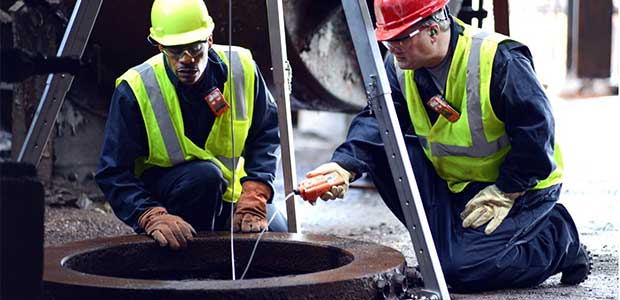
Wireless Gas Detectors Bring Connectivity to Confined Space Entries
Wireless gas detectors are changing the way we work in confined spaces.
- By Dave D. Wagner
- Jun 18, 2020
The way that we test the atmosphere within a confined space is changing. Although continuous monitoring of the atmosphere within a confined space has always been considered a best practice, many companies have traditionally found it difficult or impractical to implement. The attendant assigned to the entry can monitor the atmosphere inside the space with a portable gas monitor, but this is often cumbersome and requires additional equipment (a sampling pump and a piece of tubing or a probe). However, this setup only tests the atmosphere in one small area. Continuously monitoring the atmosphere throughout the entire space or in the area where the work is being performed is much more challenging. This is all changing thanks to wireless connectivity.
Wireless mesh technology embedded within some connected gas monitors enables the instruments to communicate with each other at a peer-to-peer level. Entrants inside the space carrying a gas detector enabled with peer-to-peer connectivity will share their readings with a connected area monitor or personal gas detector stationed with the gas tester or attendant outside the space, allowing them to “see” the readings and monitor the atmosphere through each of the entrants’ instruments.
Seeing the gas readings within a confined space is not just convenient: it saves lives. You’ve probably heard confined space horror stories like this a million times: the person inside of a confined space becomes unresponsive. The attendant responsible for monitoring the work goes into the confined space to check on his partner and is overcome by the same deadly gas. It’s a tragic story of trying to help a co-worker based on gut reaction rather than proper safety protocols. According to OSHA, these would-be rescuers make up 60 percent of confined space fatalities.
But with shared data on gas hazards, the attendant watching the hole in this example would have known what caused his partner to become unresponsive without being exposed firsthand. He could then take appropriate steps to rescue his peer, without putting himself in danger.
On top of that, the repeating capabilities of instruments in the mesh network allow workers go deep within a confined space, away from the entrance, where they could never be seen directly. Even in these locations, they can still communicate atmospheric readings back to the entrance of the space with the help of peer-to-peer wireless technology.
With this increased flexibility, peer-to-peer wireless technology in gas detectors is expanding the role of the attendant in confined space entry. One attendant is typically assigned to monitor the entrance of every confined space; however, wirelessly sharing gas readings allows one attendant to monitor the activities of multiple confined space entrants from a central vantage point.
Practical and Legal Ramifications
Many question both the practicality and legality of this approach. Technology certainly makes multi-space watching practical, and the legal position is defined clearly in the Occupational Safety and Health Administration (OSHA) confined space entry regulation. 29 CFR 1910.146 defines the attendant in a confined space entry as “an individual stationed outside one or more permit spaces who monitors the authorized entrants and who performs all attendant’s duties assigned in the employer’s permit space program.” The standard further states in 1910.146(d)(6) that “attendants may be assigned to monitor more than one permit space provided the duties described in paragraph (i) of this section can be effectively performed for each permit space that is monitored.” One attendant for multiple spaces clearly isn’t a new concept, but it is one that the use of wireless devices enables in a new and safer way. If we can wrap our minds around the use of wireless technology in this manner, it presents a tremendous advantage in efficiency and cost over conventional confined space entry procedures.
The confined space entry permit itself will be impacted by wireless technology as well. Digital permitting or electronic permitting systems are being developed to automate and simplify the permit issuing process. An electronic form on a smart device will be accessed at the point of entry and have all the appropriate procedural checklists completed. The gas readings from atmospheric testing with wireless enabled gas detectors will be transferred to the permit automatically, and all entry personnel will sign off on the permit electronically. A wireless system used to assign gas monitors and other traceable equipment to the entrants will automatically record the names of the entrants on the permit. The permit will be uploaded to a database where it can be viewed during the entry and stored permanently. The permit will be automatically updated with gas readings from continuous monitoring or periodic testing and as the work progresses or entry conditions change. Digital permitting is simply another example of how wireless technology can increase the efficiency and reduce the cost of entering a confined space.
Although it may seem like only yesterday for some, it really has been 27 years since we were first required to complete a confined space entry permit. If we continue to embrace wireless technology and the benefits it brings us, maybe those confined space entries tomorrow won’t seem so confined.